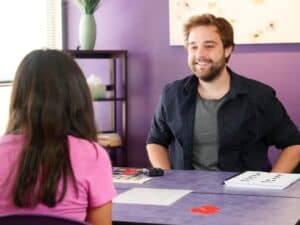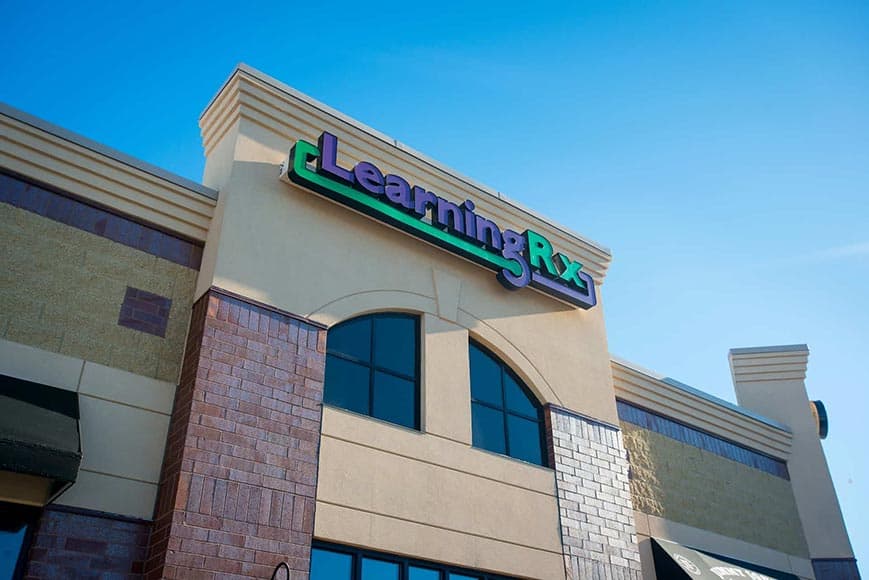Smart Mom’s Toy Box: 10 Wake-Up-Your-Brain Games
Nationally renowned brain training experts Ken Gibson and Tanya Mitchell have created a free list to help parents shop for toys, games, and brain activities that will help improve their children’s learning skills.
“Our hope is that parents will shop wisely for toys this year, purchasing toys that can help develop the cognitive skills that make learning possible—like auditory and visual processing, memory, logic and reasoning, processing speed, and attention,” says Gibson. “Research now shows that learning skills can be taught—and therefore improved. Brain skills training does for the mind what physical exercise does for the body.”
“A parent whose child has Attention Deficit Disorder, for example, would want to shop for toys that improve attention,” explains Mitchell. “Likewise, a child who struggles with reading would benefit from games that practice sound blending and segmenting.”
Gibson is the founder of national brain training franchise LearningRx, and the co-author of “Unlock the Einstein Inside: Applying New Brain Science to Wake Up the Smart in Your Child” with Mitchell.
Things to Keep in Mind
- A smart toy box will focus on all major learning skills.
- Parents can help their kids get smarter at any age.
- Brain research shows that the brain continues to grow throughout life.
- Parents should help prepare a good learner for school by developing learning skills.
- Parents should take 30 minutes three times per week to work on developing these skills.
- The best way to strengthen learning skills is to use fun, game-like activities.
- Studies show that reading problems can be prevented.
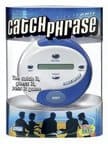
1. Catch Phrase
Welcome to electronic Catch Phrase, the battery-powered blend of clue deduction and a race against the clock. Two teams of two or more players each alternate turns, guessing the answers to clues in 11 categories, from food and drink to technology and inventions. Set the timer on the game and the clue-giving countdown begins. If a team’s guess matches the response on the game’s readout, pass the unit to your next opponent. Just don’t get caught holding this potato when the buzzer sounds; the other team will score a point. With its infectious mix of fast, nerve-wracking, high-pressure passing, electronic Catch Phrase spreads a serious case of fun. – Tony Mason
Elimination Variation (Wikipedia): A fast-paced and fun variation for large groups is to have multiple teams and play elimination style. Players split up into teams of two and are arranged in a circle, with teammates facing each other. The team starting the round will pick a category and announce it to the group. Play starts as soon as the timer is started. The player must then get their teammate to correctly say the phrase by following the rules of normal play regarding clue-giving.
If a team guesses the phrase correctly, the device is passed to the player to the left as quickly as possible, without restarting the timer, and no point is scored. If a team has the device when the buzzer sounds, the round is over and their team scores a point. When a team scores a certain amount of points they are eliminated from play, and play continues until only one team is left. The amount of points required to eliminate a team from play can vary depending on the size of the group. For instance, larger groups may find that the game moves faster if they play single elimination.
The game is similar to Taboo in which a player tries to get his or her teammates to guess words without using the word in question or five related words.
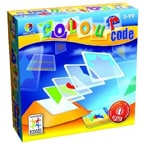
2. Color Code
Stack up the colors and shapes for 3-D matching fun! Color Code delivers a burst of fun: with 100 challenges to choose from you could play all day! It uses 18 bold, colored shapes, each on a see-through tile. Pick a challenge, then all you have to do is stack a rack of tiles to recreate the exact composition presented by your challenge! Think smart! There are several key points to remember. You need to combine shape, color, and order, and then decide how each tile should be turned around to achieve the challenge you have picked! The game includes 100 puzzle challenges, divided into four play-levels of difficulty. This game is for ages five and older.
How to play Color Code: Choose one of the puzzle challenges in the game booklet guide. Pick the tiles you need and stack them up, one by one, in the tile display holder. Don’t forget, you need to think about the shape, color and the order of the tiles, as well as which way around they need to be in the tile display holder! When your composition matches the challenge exactly, you’ve cracked the COLOR CODE! Check the solutions at the back of the game guide if you like!
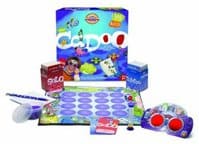
3. Cranium Cadoo or the Cranium Cadoo Lunchbox Tin Edition
Cranium Cadoo is a version of Cranium “scaled down” somewhat for kids, though this game should still appeal to adults who like Cranium. With a variety of hilarious activities, Cranium Cadoo gets kids thinking, creating, giggling, grinning, and laughing like crazy as they try to get four in a row to win. With so many different activities, there is something in Cranium Cadoo that will make every kid hoot and high-five. They might even discover a talent they never knew they had! And kids just love the cool Cranium Clay, funky tokens, and especially the secret decoder mask. Whether kids love to act, puzzle, sketch, sculpt, or even crack secret codes, Cranium Cadoo has something for everyone . . . including you! Kids work together and on their own to act, sculpt, draw, and solve puzzles, using the secret decoder mask to reveal secret words and hidden answers. The first player to get four in a row wins! Whether they’re sculpting a chocolate chip cookie out of clay or racing around the house to find something they can balance on their elbow, kids will be thinking, creating, and laughing out loud. They may even discover talents they didn’t know they had. Simple setup and easy instructions make Cadoo the perfect game for any occasion—birthday parties, after school, holidays, rainy days . . . any day!
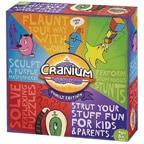
4. Cranium Family Edition
The original highly successful game of Cranium is a fantastic way for adults and older children to face off in entertaining challenges. With this new family model, everyone can play together. It employs the same four basic Cranium categories: Creative Cat, Data Head, Star Performer, and Word Worm, but within those groupings there are numerous new challenges for players of all ages. There is clay for sculpture challenges, stacking cubes, and a set of plastic frogs that players are occasionally called upon to flip. The game board is scaled back, offering a shorter length of the game. Questions and pacing are brisk and younger players (eight and older or younger kids that could play with an older teammate) would be able to have fun. It’s one of those rare family games that adults can actually enjoy playing. Cranium Family Fun gives families the best way to play together as a team in a fun game that gives everyone a chance to shine. Packed with 16 hilarious activities, Cranium Family Edition gets you building, flipping, sketching, sculpting, guessing, and laughing out loud together every time you play!
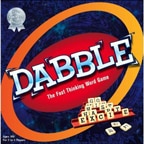
5. Dabble
Dabble is a great learning tool for kids and fun for the entire family. At the core of the game lies a fast-paced word game that will help children and adults develop many useful skills including vocabulary, spelling, and quick thinking. To play Dabble, two to four players pick 20 tiles each, then attempt to create a two- to six-letter word in five minutes. The first player to accomplish the goal receives the points from the tiles that his or her opponents were unable to use (incomplete words). If no one can create all five words, each player is allowed to trade in whichever tiles he or she does not want for new tiles and another round begins. Players may add another element by picking a subject category, such as clothing or foods. If a player is able to spell a word from that category, the point value for that word is added to the total score.
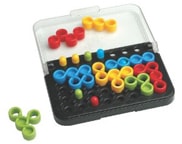
6. IQ Twist
Try to fit all the twisted playing pieces on the game board. Pay attention! You can only put a playing piece over a peg if both are the same color. This game is very compact and makes an ideal “brain snack” while on the go. It includes 100 challenges for ages six and older. Twist your brain with this logic game. Give your brain a spin in the right direction. Select a challenge and place the pegs on the game board as indicated. There are a many packing puzzles, however IQ-Twist is the first one to use pegs in order to force you use the pieces in a new way. This adds a layer of complexity not seen in most other packing puzzles. In most games like this, different challenges are made possible by starting with a few puzzle pieces already on the game board or by adjusting the size of the game board itself.
Object of the game: In every challenge, only a few colored pegs are placed on the game board. The object of the game is to place all puzzle pieces on the game board. But because of the pegs, this is only possible when there is a hole inside the puzzle piece you want to place on that exact position. And what’s more, you can only do that when the puzzle piece and the peg have the same color.
The challenges: You can use the playing pieces in any orientation, which means that that most puzzle pieces can be placed in eight different ways (except the symmetrical ones). But there are 32 places on the game board, so the number of possibilities is often quite high. The fact that there are always two pieces with the same color, makes it extra hard to determine which puzzle piece needs to fit on a specific peg. And of course most challenges only show a few pegs, so you still need to find the right place for the other ones. Challenges with fewer pegs are in most cases harder to solve, although the position of the pegs has often a bigger impact on the difficulty level than the number of pegs.
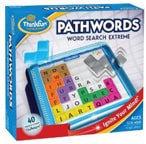
7. Pathwords
Pathwords, a single-player game from ThinkFun that combines the best of two worlds; a traditional word search and a logic puzzle. Your goal is to find all the words on the challenge card. Place the puzzle pieces so that the letters under each piece spell a word (backward or forward). When every letter is covered, you win! Its harder than you think. If you love puzzle games and you love word searches, this game has it all! The unique board holds the pieces in place and stores them, making it ideal for at home or on-the-go play.
How to play Pathwords: Choose a challenge card from the card booklet and put it on the game grid. Select the indicated puzzle pieces and place them on the board so the letters under each piece spell a word. When every letter is covered and all puzzle pieces spell a word, you win! This game is for ages 12 and older.
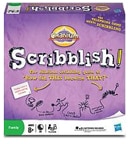
8. Scribblish
A modern spin off traditional parlor games, Scribblish will have your friends and family trying to outdo each other with imaginative drawings and hilarious comments. Get ready to put your imagination to work and scribble your way to victory as this game tosses players into a world of hilarious interpretations. Creative and outrageous fun for the whole family, Scribblish is designed for ages eight and up.
The good: Pictures and captions get funnier with each turn.
The challenging: Players have only 30 seconds to interpret, draw, or write.
In a nutshell: This is a fun and creative game requiring quick thinking and fast drawing. Fun from start to finish, Scribblish first requires each of the six players to choose a captioned card. Up against the clock, players must apply their scribbling skills as they each draw a picture to match the caption on their card. After the timer stops, players cover their images with their Scribble Scroll and roll the die to see who they’ll pass their picture to.
From there, all players must write, draw, and interpret what they see on the card for each timed round. Figure out which picture leads to your original card, or get voted as having the funniest caption or image to gain points. The results are almost always hilarious and the game is wonderfully addictive.
A built-in element of surprise: Thanks to the scribble scrolls, players will have to rely on their imaginations to win. Scribblish allows each person only one clue—either a caption or an image—to create the text or image to match what’s on the card. Much like in the childhood game of Telephone, clues change, evolve, and stretch further from their original captions as the players interpret what they see. You’ll be surprised at how easy it is to turn this into that!
Two ways to win: You don’t have to be Picasso to win this drawing game. Players can claim victory by correctly guessing which final image comes from their original card, or by being voted as having the best drawing or caption. Because each picture or comment is done by a different person, each player has an even chance of figuring out which scroll is theirs. Players can reward the clowns and artists in the group by placing tokens next to the caption or image they like best.
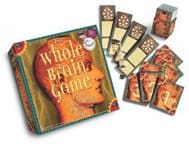
9. Whole Brain Game
It’s not what you think, but how you think it. This fun, fast-paced interactive game challenges the mind, creates outbursts of creativity and causes the players to think out of the box. Players are challenged to take unlike words or situations and create similarities, as one playing example. It causes the players to spontaneously think and shout out responses to the questions rapidly to beat the clock. A mentally and intellectually stimulating, educational and fun game all at the same time. “Right brain” activity is stimulated as players generate ideas, use their imaginations and work out patterns and relationships. At the same time the “left brain” quickly structures responses using language, logic, sequences and details. Great for families, parties, schools, and anyone that dares to think differently. Ages 11 and up, two or more players.
A player rolls an eight-sided die to determine which instruction card to use. The player follows the instructions from the Instruction card and selects the appropriate color from the category card. The player then gives as many responses to the question posed before the 30-second timer runs out. Players earn points based on the number of acceptable responses. The first player or team to 80 points wins.
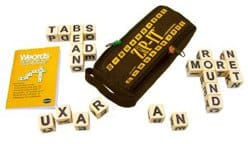
10. Zip-It
This is a 20-second word race you can play anywhere. Take 12 cubes and race against your opponent to build a word grid. One hand can be played in as little as 20 seconds and everything you need is in the bag. This exhilarating, high-speed, two-player game with 24 letter cubes comes in a unique cloth pouch with colored scoring zippers. Each pouch includes a “weords dictionary” – Get it? Weird and words combined to make weird words that help win word games. Players use 24 beautiful ivory-like letter cubes to form their own crossword grid using any side of the cubes. The first player to use ALL their own cubes calls “Zip!” and scores a point by moving their own zip up the pouch scale. The first person to score 10 points shouts “Zip-It!!” and wins the game!





